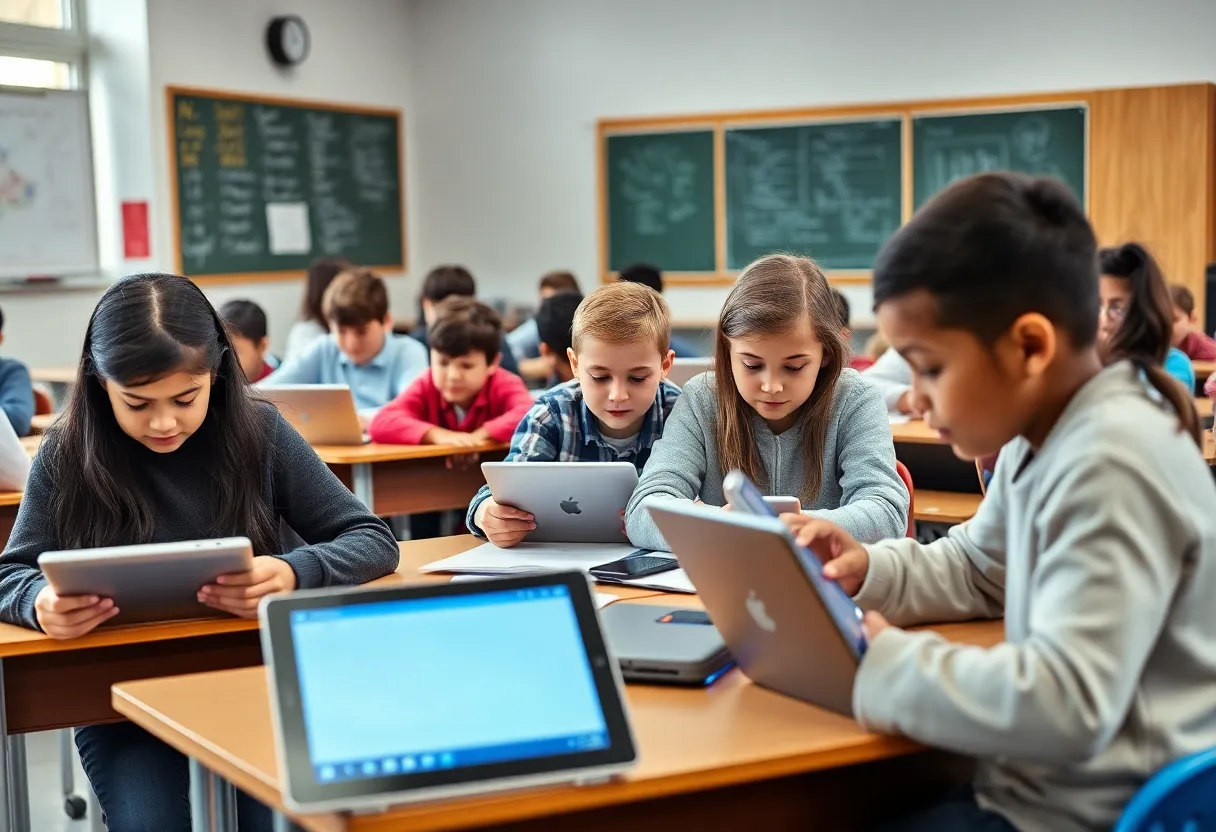Oklahoma City, October 13, 2025
Oklahoma City lawmakers are launching a comprehensive study to assess the impact of technology in classrooms on student learning. This initiative seeks to address concerns about the correlation between increased screen time and attention deficits among students. The state education committee will gather insights from educators, parents, and students to evaluate the benefits and drawbacks of technology integration, emphasizing a balanced approach to enhancing education while minimizing potential distractions. Recommendations are expected to reshape policies and promote healthier tech usage in schools.
Oklahoma City Lawmakers Launch Study on Classroom Technology Use
Oklahoma City, OK – October 13, 2025 – Lawmakers in Oklahoma City are initiating a comprehensive study on the use of technology in classrooms, focusing on its impact on student learning outcomes. This effort, spearheaded by the state education committee, addresses growing concerns about the effects of devices such as tablets and laptops on education. The study comes at a time when reports highlight a correlation between increased screen time and attention deficits among students.
Key Concerns Driving the Investigation
The primary motivation behind the study is to evaluate how prolonged exposure to digital devices influences students’ ability to concentrate and engage in learning activities. Educators have noted that while technology offers valuable tools for interactive learning, excessive use may hinder traditional skills like critical thinking and face-to-face interaction. The committee aims to strike a balance by assessing both the benefits and drawbacks of tech integration in schools.
Local insights from Oklahoma City Public Schools emphasize the need for a measured approach. Teachers and administrators stress that technology should complement, not replace, core teaching methods. This perspective has fueled the push for guidelines that prevent over-reliance on screens, ensuring devices enhance rather than dominate the classroom experience.
Scope and Methodology of the Study
The investigation will involve a detailed review of best practices implemented in other states, where similar debates have led to policy adjustments. Data collection will include input from a wide range of stakeholders, such as parents, students, and educational experts. Surveys and focus groups are planned to gather diverse opinions on how technology affects daily learning environments.
Preliminary analysis suggests that limiting daily tech use to 60 minutes could significantly boost critical thinking skills. This recommendation stems from early observations linking moderated screen time with improved academic performance and reduced behavioral issues. The study will also explore accessibility issues, ensuring that technology benefits all students regardless of socioeconomic background.
Current Context and Timeline
With the legislative session currently underway, the committee is prioritizing this issue to address it before the end of the year. Oklahoma’s education system has seen a steady increase in classroom technology over the past decade, driven by federal funding and state initiatives aimed at modernizing education. However, recent feedback from schools indicates that without proper regulation, these tools can sometimes distract more than they educate.
The study builds on previous discussions within the Oklahoma State Department of Education, where pilot programs tested various tech integration models. Results from these trials showed mixed outcomes: some classrooms reported higher engagement through educational apps, while others experienced challenges with device management and equity in access.
Potential Impacts on School Policies
Once completed, the study’s recommendations could lead to statewide guidelines that reshape how districts like Oklahoma City Public Schools incorporate technology. This might include mandatory training for teachers on effective digital tool usage, updated curriculum standards that incorporate tech limits, and increased funding for non-digital learning resources.
For students, the changes could mean more structured tech time, fostering a healthier balance between digital and hands-on activities. Parents may see clearer policies on device usage at home-school interfaces, such as guidelines for educational apps outside class hours. Overall, the initiative seeks to ensure that technology serves as a powerful ally in education without compromising foundational learning principles.
As the study progresses, updates will be shared through public forums, allowing ongoing community involvement. This collaborative approach underscores the lawmakers’ commitment to evidence-based reforms that support Oklahoma’s students in an increasingly digital world.
The focus on classroom technology reflects broader national trends, but Oklahoma’s study is tailored to the state’s unique educational landscape, including rural and urban disparities. By year’s end, the findings are expected to provide actionable steps for districts to optimize tech use, potentially setting a model for neighboring states.
FAQ
What is the main focus of the study launched by Oklahoma City lawmakers?
The study examines how devices like tablets and laptops influence student outcomes, addressing concerns about increased screen time correlating with attention deficits.
Who is leading the initiative on classroom technology use?
The initiative is led by the state education committee.
What input is being gathered for the study?
The study will review best practices from other states and gather input from parents and students.
What do preliminary findings suggest about daily tech use?
Preliminary findings suggest capping daily tech use at 60 minutes to enhance critical thinking.
When are recommendations expected from this study?
Recommendations are expected by year-end, potentially reshaping district policies.
How have local educators contributed to the discussion?
Local educators from Oklahoma City Public Schools shared testimonies today, advocating for balanced integration rather than over-reliance.
Key Features of the Classroom Technology Study
| Feature | Description |
|---|---|
| Leadership | Led by the state education committee |
| Focus Areas | Impact of tablets, laptops, and screen time on learning and attention |
| Preliminary Recommendation | Cap daily tech use at 60 minutes to boost critical thinking |
| Data Sources | Best practices from other states, input from parents and students |
| Timeline | Recommendations by year-end |
| Local Involvement | Testimonies from Oklahoma City Public Schools educators for balanced integration |
Deeper Dive: News & Info About This Topic
HERE Resources
Putnam City Schools Opens Centennial Center and Park
Oklahoma City Educators Praise Cellphone Ban as Game Changer in Classrooms
Oklahoma City University Launches New Cybersecurity Program
New Elementary School Opens in Midwest City, Oklahoma
Oklahoma City Secures $10 Million Grant for STEM Education
Oklahoma City University Unveils Innovation and Entrepreneurship Center
New Leadership Brings Stability to Oklahoma State Education Board
Oklahoma City Apprenticeship Programs Transform High School Education
Oklahoma City Launches Innovative Tech Startup Incubator
Oklahoma City: Partnerships Forge Future Workforce Pathways





